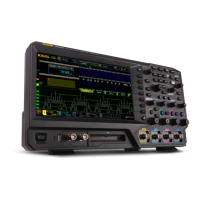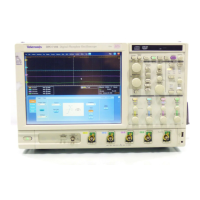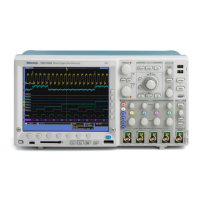Commands Listed in Alphabetical Order
Arguments
RISE causes the
instrument to take the specified measurement on a rising
(positive-going) edge of the specified source waveform.
FALL causes th
e instrument to take the specified measurement on a falling
(negative-going) edge of the specified source waveform.
EITHer caus
es the instrument to take the specified measurement on either
a rising (positive-going) or falling (negative-going) edge of the specified
source waveform.
Examples
MEASUREMENT:MEAS4:SOURCE1: EDGE:SLOPE RISE causes the instrument to
take the delay for Measurement 4 from a rising edge of the Source 1 waveform.
MEASUREMENT:MEAS4:SOURCE2: EDGE:SLOPE? might return
MEASUREMENT:MEAS4:SOURCE2: EDGE:SLOPE FALL, indicating that the
delay for Measurement 4 is taken to a falling edge of the Source 2 (destination)
waveform.
MEASUrement:MEAS<x>:SOUrce<x>:GATE<x>? (Query Only)
This q
uery-only command returns all gate settings of the specified gate for the
specified measurement o n the specified source waveform. The measurement slot
is specified by x, which can be 1 through 8; the s ource is specified by x, which can
be 1 or 2; a nd the gate is specified by x, which can be 1 or 2.
NOTE. The SOURCE<x> SOURCE:<<x> argument specifies the
source, which can be source 1 or source 2. To set the actual waveform
(c
hannel, reference, or math) that is assigned to source, you must use the
MEASUrement:MEAS<x>:SOURCE<x> WFM command. Two sources are
provided because some measurements (gain, phase) require two sources.
Group
Measurement
Syntax
MEASUrement:MEAS<x>:SOUrce <x>:GATE<x>?
Examples
MEASUREMENT:MEAS1:SOURCE1: GATE1? might return
MEASUREMENT:MEAS1:SOURCE1: GATE1 POS 20.25000000000E-9;PCTPOS
25.00000000000
.
DSA/CSA/TDS8X00/B Series Programmer Manual 2-239

